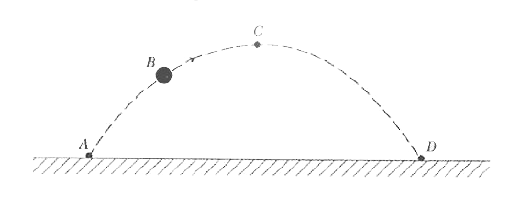A tennis ball is thrown upward at an angle from point A. It follows a parabolic trajectory and hits the ground at point D. At the instant shown, the ball is at point B. Point C represents the highest position of the ball above the ground.

Which statement is true concerning the ball when it is at C, the highest point in its trajectory?
The ball's velocity and acceleration are both zero.
The ball's velocity is perpendicular to its acceleration.
The ball's velocity is not zero, but its acceleration is zero.
The ball's velocity is zero, but its acceleration is not zero.
The correct Answer is:B
Step by step video, text & image solution for A tennis ball is thrown upward at an angle from point A. It follows a parabolic trajectory and hits the ground at point D. At the instant shown, the ball is at point B. Point C represents the highest position of the ball above the ground. Which statement is true concerning the ball when it is at C, the highest point in its trajectory? by Physics experts to help you in doubts & scoring excellent marks in Class 12 exams.
Updated on:21/07/2023Topper's Solved these Questions
- MOTION IN TWO AND THREE DIMENSIONSBOOK - RESNICK AND HALLIDAYCHAPTER - MOTION IN TWO AND THREE DIMENSIONSEXERCISE - PRACTICE QUESTIONS (MATRIX-MATCH)
10 Videos
- MOTION IN TWO AND THREE DIMENSIONSBOOK - RESNICK AND HALLIDAYCHAPTER - MOTION IN TWO AND THREE DIMENSIONSEXERCISE - PRACTICE QUESTIONS (MORE THAN ONE CORRECT CHOICE TYPE)
3 Videos
- MOTION ALONG A STRAIGHT LINEBOOK - RESNICK AND HALLIDAYCHAPTER - MOTION ALONG A STRAIGHT LINEEXERCISE - PRACTICE QUESTIONS ( Integer Type )
3 Videos
- OSCILLATIONSBOOK - RESNICK AND HALLIDAYCHAPTER - OSCILLATIONSEXERCISE - Practice Questions
57 Videos
Similar Questions
Knowledge Check
A tennis ball is thrown upward at an angle from point A. It follows a parabolic trajectory and hits the ground at point D. At the instant shown, the ball is at point B. Point C represents the highest position of the ball above the ground.

While in flight, how do the x and y components of the velocity vector of the ball compare at the points A and D?AThe velocity components are non-zero at A and are zero m/s at D.BThe velocity components are the same in magnitude and direction at both points.CThe velocity components have the same magnitudes at both points, but their directions are reversed.DThe velocity components have the same magnitudes at both points, but the directions of the y components are reversed.A tennis ball is thrown upward at an angle from point A. It follows a parabolic trajectory and hits the ground at point D. At the instant shown, the ball is at point B. Point C represents the highest position of the ball above the ground.

While in flight, how do the x and y components of the velocity vector of the ball compare at the points B and C?AThe velocity components are non-zero at B and zero at C.BThe x components are the same, the y component at C is zero m/s.CThe x components are the same, the y component has a larger magnitude at C than at B.DThe x component is larger at C than at B, the y component at B points up while at C, it points downward.A ball is thrown upwards from a point A.It reechec up to the highest point B and returns.
AKinetic energy at A= kinetic energy at BBPotential energy at A= potential energy at BCPotential energy at B= kinetic energy at BDPotential energy at B= kinetic energy at A
A ball is thrown upwards and returns to the ground describing a parabolic path. Which of the following quantities remains constant ?
View SolutionA ball is hit at 45∘ to the horizontal with a kinetic energy EK. The kinetic energy at the highest point is :
View SolutionA ball is hit at 45∘ to the horizontal with a kinetic energy EK. The kinetic energy at the highest point is :
View SolutionA ball is thrown horizontally from the top of a tower 40 m high. The ball strikes the ground at a point 80 m from the bottom of the tower. Find the angle that the velocity vector makes with the horizontal just before the ball hits the gound.
View SolutionA ball is thrown straight upward with a speed v from a point h meter above the ground. The time taken for the ball to strike the ground is
View Solution
